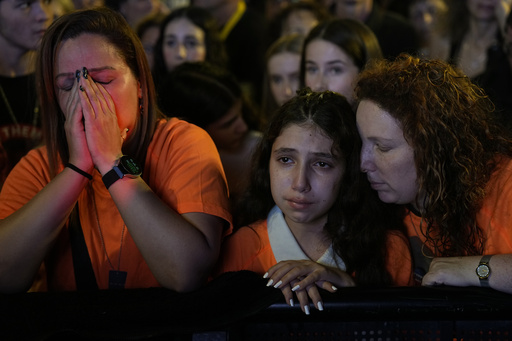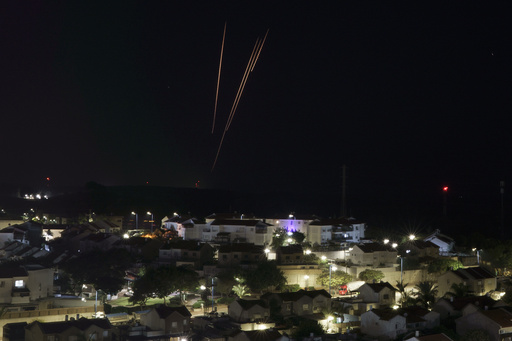Israeli offensive shifts to crowded southern Gaza, driving up death toll

Palestinians flee from east to west of Khan Younis, Gaza Strip, during the ongoing Israeli bombardment, Saturday, Dec. 2, 2023. AP
KHAN YOUNIS, Gaza Strip — Israel pounded targets in crowded southern Gaza on Saturday and ordered more neighborhoods designated for attack to evacuate, driving up the death toll as the United States and others urged it to do more to protect civilians a day after a truce collapsed.
The prospect of further cease-fires in Gaza appeared bleak, as Israel recalled its negotiators and Hamas’ deputy leader said any further swap of Gaza-held hostages for Palestinians imprisoned by Israel would only happen as part of ending the war.
“We will continue the war until we achieve all its goals, and it’s impossible to achieve those goals without the ground operation,” Prime Minister Benjamin Netanyahu said in an address Saturday night.
At least 200 Palestinians have been killed since the fighting resumed Friday morning following the weeklong truce with the territory’s ruling militant group Hamas, according to the Health Ministry in Gaza. Several multi-story residential buildings were hit on Saturday, engulfing neighborhoods in huge clouds of smoke.
Separately, the ministry said the overall death toll in Gaza since the Oct. 7 start of the war had surpassed 15,200, a sharp jump from the previous count of more than 13,300 on Nov. 20. The ministry does not differentiate between civilian and combatant deaths, but it said 70% of the dead were women and children. It said more than 40,000 people had been wounded since the war began.
Article continues after this advertisement“Too many innocent Palestinians have been killed. Frankly, the scale of civilian suffering and the images and videos coming from Gaza are devastating,” U.S. Vice President Kamala Harris told reporters during the COP28 climate conference in Dubai.
Article continues after this advertisementAppeals from the U.S., Israel’s closest ally, to protect civilians came after an offensive in the first weeks of the war devastated large areas of northern Gaza. Some 2 million Palestinians, almost Gaza’s entire population, are now crammed into the territory’s southern half.

Relatives and friends of hostages held in the Gaza Strip by the Hamas militant group call for their release in the Hostages Square at the Museum of Art in Tel Aviv, Israel, Saturday Dec. 2, 2023. AP
Israel’s military said it had hit more than 400 Hamas targets across Gaza over the past day, including more than 50 in Khan Younis city and surrounding areas in the south.
Palestinian Red Crescent spokesman Mahmoud Basal told broadcaster Al-Jazeera that there were more than 300 “martyrs” in Gaza City’s Shujaia neighborhood and that homes were flattened. Israel’s military said it killed Hamas’ Shujaia battalion commander but gave no details on the operation. Residents could not be reached.
In northern Gaza, an airstrike flattened a building hosting families in the urban refugee camp of Jabaliya on Gaza City’s outskirts. It left dozens dead or wounded, said residents Hamza Obeid and Amal Radwan.
“The building turned into a pile of rubble,” Obeid said. AP video showed smoke rising as men, some in sandals, picked their way over debris. The Israeli military confirmed it was operating in Jabaliya and said it had found and destroyed Hamas tunnels in the surrounding area.
A powerful strike hit a cluster of multi-story buildings in Hamad City, a Qatari-funded housing development on the outskirts of Khan Younis. Smoke engulfed the complex. There was no immediate word on casualties.
“Where is it safe? I swear to God, no one knows, where are we going?” asked Zohair al Raai, who said his family received a recorded message saying their building should evacuate.
Also in the south, at least nine people, including three children, were killed in a strike on a house in Deir al-Balah, according to the hospital where bodies were taken.
Meanwhile, Palestinian militant groups in Gaza said they fired a barrage of rockets on southern Israel. Lt. Col. Peter Lerner, an Israeli army spokesperson, said Hamas had launched more than 250 since the cease-fire ended. There were no immediate reports of injuries.
During a Saturday visit to Israel and the West Bank city of Ramallah, an International Criminal Court prosecutor said his office is serious in moving forward to investigate allegations of war crimes on both sides.
“Every actor should be without doubts that they must comply with the law now,” Karim Khan told broadcaster Palestine TV. “And if you don’t comply with the law now, don’t complain later.”
With the resumption of fighting, the Israeli military published an online map carving up Gaza into hundreds of numbered parcels and asked residents to familiarize themselves with the number of their location ahead of evacuation warnings.
On Saturday, the military listed more than two dozen parcel numbers around Gaza City and east of Khan Younis. Separately, it dropped leaflets with evacuation orders over towns east of Khan Younis.

Rockets are fired toward Israel from the Gaza Strip as seen from southern Israel, Saturday, Dec. 2, 2023. AP
One Khan Younis resident said a neighbor received a call from the Israeli army warning that houses in the area would be hit. “We told them, ‘We have nothing here, why do you want to strike it?’” said the resident, Hikmat al-Qidra. Al-Qidra said the house was destroyed.
The maps and leaflets generated panic and confusion in the crowded south, where people cannot go to northern Gaza or neighboring Egypt and are left to move around within the 220-square-kilometer (85-square-mile) area.
“There is no place to go,” said Emad Hajar, who fled to Khan Younis a month ago. “They expelled us from the north, and now they are pushing us to leave the south.”
Mark Regev, a senior advisor to Netanyahu, said Israel was making “maximum effort” to protect civilians and the military has used leaflets, phone calls, and radio and TV broadcasts to urge Gazans to move from specific areas. He added that Israel is considering creating a security buffer zone that would not allow Gazans direct access to the border fence on foot.
Israel says it targets Hamas operatives and blames civilian casualties on the militants, accusing them of operating in residential neighborhoods. It claims to have killed thousands of militants, without providing evidence. Israel says 77 of its soldiers have been killed in the offensive in northern Gaza.
Also Saturday, the Palestinian Red Crescent said it had received the first convoy of aid trucks through the Rafah crossing with Egypt since fighting resumed. Wael Abu Omar, a spokesman for the Palestinian Crossings Authority, said 100 trucks entered including three carrying 150,000 liters (nearly 40,000 gallons) of fuel.
Meanwhile, Harris told Egyptian President Abdel Fattah Al-Sisi in a meeting that “under no circumstances” would the U.S. permit the forced relocation of Palestinians from Gaza or the West Bank, an ongoing siege of Gaza or the redrawing of its borders, according to a U.S. summary.
The Oct. 7 attack by Hamas and other militants killed about 1,200 people, mostly civilians, in southern Israel. Around 240 people were taken captive.
The renewed hostilities have heightened concerns for 137 hostages, who the Israeli military says are still being held after 105 were freed during the truce. A 70-year-old woman held by Hamas was declared dead on Saturday, according to her kibbutz. She is the eighth hostage known to have died.
At a rally of tens of thousands in Tel Aviv, released hostages called for the rest to be freed. In a video address, Yaffa Adar, 85, spoke up specifically for children being held, saying, “I want to see them now — not when I’m in a coffin.”
Hamas and Israel differed on who was still being held.
Hamas’ deputy leader, Saleh Arouri, told Al-Jazeera that any remaining hostages are men who served in the Israeli military. That contradicted another top Hamas official, Osama Hamdan, who told The Associated Press on Friday the group was willing to trade more hostages but rebuffed an Israeli demand to release 10 female soldiers.
Israel’s Defense Minister Yoav Gallant said Hamas violated the truce agreement by refusing to return two children and 15 women.
During the truce, Israel freed 240 Palestinians. Most of those released by both sides were women and children.